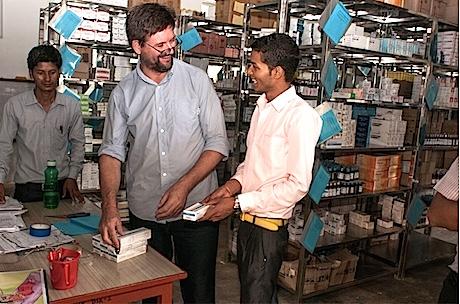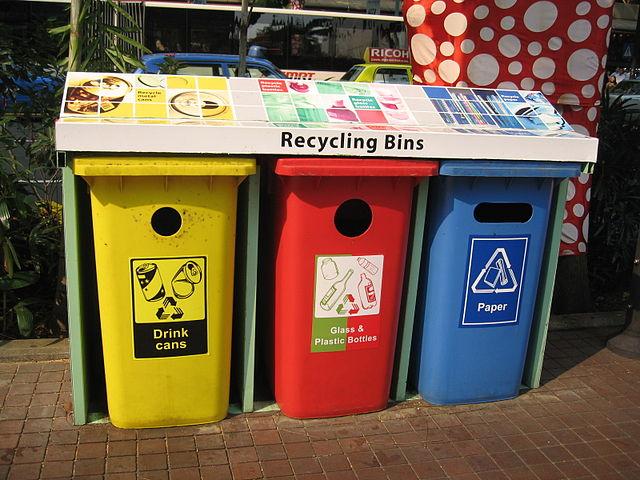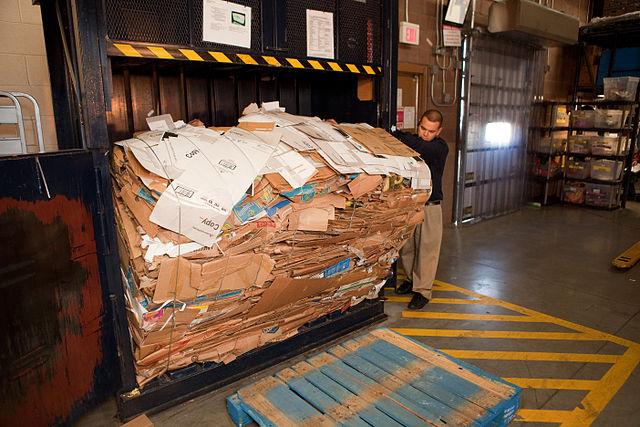America's Top 5 Renewable Energy Companies


If we have any chance of avoiding the worst impacts of climate change, we will have to completely embrace renewable energy. The reason why is simple: Renewable energy produces little or no greenhouse gas emissions.
Electricity production is over a third of U.S. GHG emissions, and the majority of those emissions are caused by coal-fired power plants, which produce about 25 percent of the nation’s emissions. While coal emits between 1.4 and 3.6 pounds of carbon dioxide equivalent per kilowatt-hour (C02E/kWh), wind emits just 0.02 to 0.04 pounds of C02E/kWh and solar only 0.07 to 0.20.
The Environmental Protection Agency launched the Green Power Partnership (GPP) in 2001 to increase the use of renewable energy among American companies. It a voluntary program which encourages organizations to use renewables.
The GPP produces a National Top 100 list of the largest renewable energy users within its participants. And the combined renewable energy use of the top 100 partners is almost 30 billion kilowatt-hours a year, representing over 83 percent of the renewable energy commitments made by all GPP partners.
America's top five renewable energy companies
Looking at the top five companies on the GPP’s National Top 100 list proves the U.S. can widely adopt renewable energy. And it shows that business can continue to lead the way in renewable energy use regardless of who is in the White House.1. Intel
The tech company that bills itself as the world leader in silicon innovation is in the GPP’s top spot for the eighth consecutive year. The company buys over 3.4 billion kWh a year of renewable energy certificates (RECs) generated from wind, solar, geothermal, low-impact hydropower and biomass projects from third-party certified sources. The company's REC purchases are equivalent of removing over 455,000 cars from the road every year, or avoiding the amount of electricity needed to power over 327,000 average American homes annually.
Intel also has 58 wind micro-turbines perched on top of its worldwide headquarters in Santa Clara, California. It is one of the largest operating rooftop wind micro-turbine arrays in the world. Each of the turbines is between six and seven feet tall, weighing about 30 pounds. Each micro-turbine can produce about 65 kWh of power a year.
2. Microsoft
One of the largest technology and software companies in the country, Microsoft purchased over 1.3 billion kWh of renewable energy annually in recent years. As a result of its use of renewables, combined with energy-efficiency measures and investments in carbon-reduction projects, the company met its goal to reduce carbon emissions by at least 30 percent per unit of revenue below a 2007 baseline.
Microsoft has been 100 percent powered by renewable energy through its REC purchases, power purchase agreements (PPAs) and on-site energy since 2014. Here are some highlights of Microsoft’s use of renewables:
- In 2013, the company signed a 20-year agreement to buy 100 percent of the output of the Keechi Wind project, a 110-megawatt wind farm in Keechi, Texas.
- In 2014, the company bought 175 MW of wind energy from the Pilot Hill wind project in Illinois. The project generates more than enough electricity to power its Chicago data center and 70,000 Illinois houses.
- Microsoft installed a rooftop solar array at its Silicon Valley campus in 2006, which generates 480 kilowatts at peak capacity.
The company with over 1,160 department stores in 49 states entered select stores into a PPA with SunEdison for a 20-year term in 2007.
As a result, the solar power systems provide about 40 percent of each store’s power. As of December 2015, the company had 163 solar power systems in 15 states.
The largest solar panel system is installed at its E-Fulfillment Center 3 in Edgewood, Maryland. It features 8,360 solar panels which generate over 3 kWh of energy a year, enough to supply 317 homes annually.
Kohl’s also invests in wind power. In 2011, it installed wind turbines on two locations. One of those was at its distribution center in Findlay, Ohio, where wind turbines generate 40,000 kWh a year.
4. Cisco Systems
Cisco purchased over 1.2 billion kWh of renewables globally in 2016, which represent about 100 percent of its total U.S. electricity use.
Cisco achieved the milestone through on-site renewable power, green power contracts with utilities, offsite power opportunities, and RECs.
From 2012 to 2016, the company increased its total on-site solar photovoltaic (PC) capacity from 200 KW to 2.7 MW. And those solar power systems produce on average 1.7 million kWh of power, which avoid over 1,200 metric ton of carbon equivalent annually over the projected 25-year life of the systems.
5. Google
As of April 2016, Google signed 15 long-term agreements for over 2,000 MW of wind and solar energy, which is enough to power about 670,000 homes.
The company has committed almost $2.5 billion to renewable energy projects, representing a total capacity of over 3.7 gigawatts. That's enough to power 1 million homes. And Google uses renewable energy to power over 35 percent of its operations.
Image credit: Pexels
Water Woman: How Leadership Turned An Israeli City Into a Global Model for Water Efficiency


Rishon LeZion, five miles south of Tel Aviv, was founded in the 1880s by Jewish immigrants who fled the poverty and pogroms of Russia. Now the fourth-largest city in Israel, what was once a small farming community has become one of the most prosperous cities in the country.
Drive along the city’s wide thoroughfares, and except for the Hebrew on store fronts and office buildings, you could just as well be in suburban Houston, Northern Virginia or the Inland Empire. But Rishon LeZion has also become a world leader in water efficiency -- and without the reliance on expensive technologies.
Its water utility, Meniv Rishon, is a compelling study of how strong leadership can transform a water company into a dynamic force that becomes central to people’s lives.
In much of the world, water services are very much engineering- and process-driven. (And in the U.S., as I’ve been told a few times off the record, the industry is one dominated by stodgy middle-aged white men.) Delivering fresh water and hauling away sewage is really not that complicated – hence anyone who is trying to shake up a water company will often be told, “This is the way we’ve always done it.”
But many water companies worldwide are beginning to realize that doing things “the way we’ve always done it” has become the fast track to a failure in delivering this vital resource. The onslaught of droughts, surging populations, weak pricing strategies and decaying infrastructure means that water utilities are under even more pressure to deliver clean water.
On that last point, much of the world’s water infrastructure is in a sorry state. Statistics on water loss are all over the map. One NGO suggests that aging infrastructure causes approximately 6 billion gallons of water to be lost through broken water mains and leaky pipes in the U.S. – totaling anywhere from 14 to 18 percent of the nation’s water supply. An estimated 240,000 water mains broke in 2013 alone.
In developing countries, that percentage is even higher. Water-rich Brazil, for example, suffers water leakage rates of as high as 35 percent. The results are more damage to the local infrastructure, increased water scarcity, and lost revenues for water utilities as they cannot charge citizens for a resource that was never received.
“But it’s important to keep in mind those figures are averages, and the real impact is at the municipal level,” said Kate Zerrenner, manager of energy-water initiatives for the Environmental Defense Fund’s Climate and Energy Program. “The average city in the U.S. loses up to 30 percent ... There are some cities that are doing really well, keeping losses to under 10 percent. But others like Houston, Dallas and San Antonio, Texas, range from 15 to 20 percent water loss.”
In Israel, however, water loss is only an estimated 10 percent nationwide. But there's still room for improvement.
Enter Sally Levy, CEO of Meniv Rishon. She seems unassuming at first – when I first met her in the company break room, where she was restocking a cabinet, I figured she was one of the utility’s rank-and-file employees. After all, the glass ceiling in this nation of 8 million is still way too high for many women. (“It’s rare to see a female CEO in Israel,” grumbled a woman executive at a panel during my time in Tel Aviv.) But as Levy spoke about her company during our afternoon visit, it was clear she was a force to be reckoned with – and serves as an example of how strong leaders can get things done and earn the trust of its customers and stakeholders.
It is not easy for a woman to work in a high-level executive position in Israel’s patriarchal society, but Levy makes it look like a breeze. A large part of her success lies in her indefatigable confidence. She also displays a deft personal touch, as she knows when to play the woman card – and does so in a subtle and brilliant way. One thing we noticed while touring Meniv Rishon’s facilities is that they are practically spotless and hyper-organized. “The men may not like it sometimes because I make them clean,” she boasted, “but I take good care of them and treat them with respect.” That respect was mutual: The burly men we saw in various offices and workshops clearly held her in high esteem and without any condescension.
Levy’s personal touch goes beyond her employees. While she is hardly a micro-manager, she treats customer service as if it is one of her key performance indicators. From her point of view, she really had no choice.
In the wake of Israel’s massive drought at the end of the last decade, the country embarked on a massive water infrastructure spending binge that was heavy on desalination investment. As a result, the average water bill for a Rishon LeZion household spiked from 60 shekels to 300 shekels every two months (US$12 to $75).
That may seem like a reasonable price within a water-stressed nation, but Levy’s customers were furious. In turn, she reached out to many of them, sometimes to the detriment of her personal life. “Recently, I got a call from a customer at 12:45 in the morning one Friday about a burst pipe,” she said, half laughing. “And that was the end of my weekend!”
But it is because of this personal approach that Meniv Rishon has a proactive culture that has led to minimal water losses while grooming the utility as a model of water efficiency.
So, what did this company do to minimize its water losses? Read about it tomorrow on TriplePundit.
Image credit: 1) Meniv Rishon; 2) Kate Zerrenner
Editor’s note: Vibe Israel is funding Leon Kaye’s trip. Neither the author nor TriplePundit were required to write about the experience.
Are Smart Cities Really 'Smart?'


By Katie McBeth
We are on the brink of a new age. With the ever advancing temperatures and the increasing access to technology, our world is steadily creating a new era of intermixing tech and nature. The evolution of cities are a product of this change. From the age of ports, to industrial hubs, to tech giants. Now, a new generation of cities are being born -- the smart city. But are they living up to their expectations?
Smart cities were created initially to bring in the brightest minds to change and innovate the technology industry. As global warming continued to bode ill on the horizon, technology shifted its direction slightly. The new trend was “green,” and inventions were aimed at creating a difference for both the consumer and our world.
Yet smart cities are still struggling in many ways to make a positive impact on the environment. These hubs are generally known for their high and toxic emissions, massive amounts of waste, and slow adjustment to rapid population growth. Even despite some of their best efforts, they are lagging behind the international standard and expectations.
The United Nations released its 2030 Sustainable Development Goals last year. The 17 goals were aimed at both rural and urban populations, with a special interest in sustainable economies and infrastructures. So far, many urban areas have fallen short of their projected growth and are continuing to harm the air we breathe.
However, much of the problems presented by smart cities can be mitigated through the integration of technology, specifically the Internet of Things (IOT).
Creating a smarter network
A few researchers have touched on the pitfalls of smart cities, but the general consensus seems to be a lack of infrastructure and governance.
Unfortunately for the U.N. (and the world), many of the world’s largest cities conduct production and infrastructure under their own unique set of country-wide, state-wide or city-wide laws, with varying levels of funding for each. What may be a standard for Beijing is definitely not the same for New York City; and the costs are astronomically different. Thus, smart cities are often constructed with a top-down approach that leaves massive gaps between citizens, businesses and government.
David Thorpe, an energy consultant, notes this in his article on a report focused on smart grid cities in the U.K.:
“The problem [the report] identifies is that cities are constrained in their efforts to meet environmental challenges by a range of factors: not simply 'lack of money' but lack of control over how that money is spent in their area. Also a lack of any long-term certainty over levels of funding from central government, and an overcomplicated system of local government, where key powers and responsibilities are shared across different levels and by different institutions often varying from city to city.'”
Luckily, IOT has the ability to mitigate some of these greater bureaucratic hurdles. Through an interconnected web of data analysis, the city can monitor and administer to needs on an individual level. Small businesses that need a fraction of the energy as their corporate neighbors can be excluded from the larger equation of emissions. Corporations that actively work to cut back on energy or waste will be noticed for their efforts, and the city can make adjustments for those that need the help. On a consumer level, the possibilities are endless: from traffic control, to waste management, to safety monitoring.
IOT connected devices are also giving many cities the opportunity to re-vamp; even bringing some cities out of their decades-long recession. For Pittsburgh in the United States, this opportunity began with the introduction of the driverless car by Uber, providing the “rust-belt” city with an opportunity for massive innovation and a potentially greener future; despite the fact that the vehicle of choice, the Volvo XC90, is gas powered.
Although many consumers don’t see an immediate end to the driven car, innovators within the tech industry are determined to bring on this next evolution of car manufacturing. They see a potential for technology to bring on easier commutes, less pollution and a more cohesive flow to traditional city life. It’s through this next development in independence and cohesion through IOT that many cities will be able to break their dependence on oil and carbon emissions, and innovators in tech are ready and willing to step up to make it happen.
Rerouting the economy
Another major pitfall in the smart-city landscape is the type of economy many of these cities function under. Unlike the U.N.’s plan to create a sustainable infrastructure in major cities, most of the urban areas around the world function on a “take, make and destroy” linear framework. This leads to massive amounts of waste, much of which can be easily recycled or repurposed.
The circular economy is a model that can help change that framework. As Rutgers University explains, the circular economy model is aimed to create a “closed loop” on production, with incentives for business to create greener, reusable products and an increase in overall recycling. In the European Union, it has been especially promising. The EU's current plan has allowed for over 65 percent of municipal waste and 75 percent of packaging waste to be recycled since instigating the change in December 2014.
Of course, forging a new economy is easier said than done. Corporations on an international level will need to cooperate with each other, and governments will need to step up to enforce a fluid transition. For the major producers of waste -- primarily the United States -- this may be an extremely difficult endeavor. However, international examples such as the EU set a high bar that is extremely successful.
In this way, IOT can help as well. IOT can help monitor the cycle from production, to use, to waste, and through to repurposing. As Techcrunch illustrates: “[Circular economies] combine the principles of a regenerative and restorative economy, where the utilization and useful life of assets is extended, with IoT technologies, which provide information about the condition, location and availability of those assets, and there may be an even greater opportunity to scale new models more effectively, while providing new direction to the digital revolution.”
For smart cities to continue on and create an active difference on our environment, they will need to embrace the innovative future of IOT and look into cultivating a circular economy. Through repurposing waste, managing energy output, and controlling emissions from both cars and manufacturing, they may be able to slowly reverse their negative effects on the planet. Luckily, the tech world is more than willing to help once they’re given the go-ahead. The trick, of course, is convincing the world governments that it’s worth giving a try.
Image credit: Pexels
Katie McBeth is a freelance writer out of Boise, ID, with experience in marketing for small businesses and management. She spends her free time being the mother of three cats and a dog named Toby. You can follow her animal and writing adventures on Instagram or Twitter: @ktmcbeth.
Companies may have to reveal pay gap between executives and employees


MSD lends its best employees to NGOs around the world


Why Are American Recycling Rates Still Stuck At 34 Percent?


As environmental awareness grew, U.S. recycling rates saw a rapid uptick in the 1980s and '90s. But the U.S. recycling rate has been stuck at around 34 percent for the past decade. In the meantime, consumption continues to grow, meaning more recyclable goods are ending up in landfills across the country. This is unsustainable. It's time to jump start recycling and get us back on the path toward a circular economy.
So, why are we stuck? There are many factors at play. The initial gains were mostly in cities that could set up efficient recycling systems at a lower cost. Unfortunately, suburban, exurban and rural areas have been slow to adopt municipal recycling.
Gaps in consumer education also are a problem, as recycling regulations vary greatly from municipality to municipality, making it tough to know how to recycle properly.
Lastly, cost-effectiveness is a limiting factor. Recyclers need to utilize all the goods made from recycled waste, and it's not necessarily cheap -- especially when low gas prices keep, for example, virgin plastic cheaper than recycled plastic. It is no surprise that many opt for the former.
There is also an infrastructure challenge at play. As alluded to above, we lack centralized waste management systems in the United States: Nearly all are run at the city or county level by a myriad of public and private operators, all with varying levels of competency.
Some cities have made huge progress, such as Philadelphia – which quadrupled its recycling rate in just four years. Others, like where I grew up in Johnson County, Kansas, still lack free curbside recycling.
"A fragmented waste management system and the need for greater investment and capital in recycling infrastructure are [one of] many reasons the U.S national recycling rate has hovered around 34 percent," Jennifer Gerholdt, senior director of the environment program for the U.S. Chamber Foundation’s Corporate Citizenship Center, told TriplePundit.
This is an economic problem as well. Companies want to use more recycled content in their production. Coca-Cola, for example, has set a goal to use 25 percent recycled PET in its bottles, but has been unable to meet the timelines due to the challenge of getting enough recycled content.
Last month, the U.S. Chamber Foundation launched an ambitious project to change this. Beyond 34 aims to not only boost recycling, but also increase the recovery of reusable goods -- with the ultimate goal of getting us to a fully closed-loop, circular economy.
"We [aim to] tackle the recycling and recovery gap in the U.S., and accelerate infrastructure development necessary to build and optimize closed-loop systems at the scale of the local economy," Gerholdt told us.
The partnership aims to break through the 34-percent barrier through education, partnership-building, and increasing knowledge about how to take advantage of what they call a $4.5 trillion circular economic opportunity. Local Chambers across the country will be empowered to work with their municipalities directly, with resources and aid from the national foundation.
"We will support local municipalities and others to provide mentorship and education to help them take advantage of recycling, reuse and recovery infrastructure projects, construct the economic business case and opportunity for reprocessing these materials, and identify additional priority fundable projects and develop recycling business plans," she explained.
Another place to look for inspiration is abroad. Many European countries have broken through the 34-percent barrier. Some, such as Sweden, have such a strong recycling and recovery infrastructure in place that they are actually importing trash.
The Chamber Foundation seems ideally placed to help companies and governments work together to both increase recycling rates and provide more recycled inputs at low costs to help companies meet their sustainability goals.
The ideal would be implement what San Francisco aims to do. There, the city's recycling authority has the goal of being able to recycle almost anything the material world puts out through a mix of expanding citywide composting systems and new technologies that can better separate and recycle content.
We need to get better at this, and fast. This is becoming even more pressing with the global boom in e-commerce. More e-commerce means more goods are being delivered straight to people's homes and, oftentimes, that means more packaging. Cities are already becoming overwhelmed by cardboard from rapid delivery services like Amazon Prime and Google Express and startups like Blue Apron, which send you pre-portioned ingredients in a recyclable package.
We'll all need to work together to break through the 34-percent glass ceiling and hit the ultimate goal – 100 percent recycling and re-usability. Only then can we say that our waste management system is truly, genuinely sustainable.
Image credit: Terrance Ong via Wikimedia Commons
Rex Tillerson: From Climate Con Artist to Secretary of State


Editor's Note: A version of this post originally appeared on the Huffington Post.
By Elliott Negin
Donald Trump’s unorthodox selection of ExxonMobil CEO Rex Tillerson for secretary of state touched off a flurry of stories about how an engineer from humble beginnings rose through company ranks to become one of the world’s most powerful corporate titans, negotiating with potentates and presidents in dozens of countries spanning the globe.
Much of the coverage focused on Tillerson’s chummy relationship with Russian President Vladimir Putin, which has raised eyebrows among Democrats and Republicans alike, including Sens. Lindsey Graham, John McCain and Marco Rubio. Tillerson’s bromance with the Russian strongman, however, has largely overshadowed another major area of concern: ExxonMobil’s leading role in promoting climate science denial and blocking government efforts to address global warming.
Instead of exploring those issues, many news organizations have accepted the statements Tillerson and his lieutenants have made about company climate policy at face value. A closer look, however, shows that while Tillerson may talk the talk, when it comes to walking, he’s heading in the wrong direction.
Climate change risks may be serious, but...
As a number of reporters have noted, Tillerson — unlike his crusty predecessor, Lee Raymond — acknowledges that climate change is a problem.
“At ExxonMobil,” Tillerson said in May at a conference in Washington, D.C., “we share the view that the risks of climate change are serious and warrant thoughtful action.”
That sounds promising, right? But Tillerson followed that statement by noting that more than a billion people around the world lack access to electricity, living in what he called a state of “energy poverty.” Cutting back on fossil fuels, Tillerson argued, would condemn them to a life of deprivation. His solution: more fossil fuels, especially natural gas. As he has said on other occasions when addressing the same topic: “What good is it to save the planet if humanity suffers?”
Tillerson also routinely disparages well-established climate models, insisting they are inaccurate. Instead, he recommends societies learn how to adapt to sea-level rise and other consequences of global warming instead of trying to reduce carbon emissions.
“Changes to weather patterns that move crop production areas around — we’ll adapt to that,” he said during a talk at the Council of Foreign Relations in June 2012. “It’s an engineering problem and it has engineering solutions. ...The fear factor that people want to throw out there to say we just have to stop this [carbon emissions from burning fossil fuels], I do not accept.”
Tillerson reiterated his disdain for climate science before a much larger audience the following March. During an hour-long interview on PBS’ Charlie Rose, he emphasized uncertainty — exactly what ExxonMobil did after its own scientists warned upper management in the late 1970s about the potential for climate catastrophe.
“We have continued to study this issue for decades,” Tillerson told Rose. “ ... With all of that [new data, better models, and more competent analysis, though, the facts remain there are uncertainties around the climate, climate change, why it’s changing, what the principal drivers of climate change are.”
Social scientists call that “manufacturing doubt.” That’s just what the tobacco industry did to stave off tighter government controls on its product despite the fact that the science linking smoking to cancer and other diseases was conclusive — just as climate science is today.
Does ExxonMobil really support a carbon tax?
Stories about Tillerson’s nomination in the Wall Street Journal, the New York Times and other publications uncritically repeated ExxonMobil’s hollow assertion that it endorses a carbon tax.
As I have previously pointed out, Tillerson first claimed to back a revenue-neutral carbon tax in 2009 in a cynical attempt to derail congressional approval of a rival approach — a market-based, cap-and-trade system — that was gaining ground at the time. In fact, a cap-and-trade bill did pass narrowly in the House, only to die later in the Senate.
Not only was Tillerson undoubtedly aware back then that a carbon tax had virtually no political support, since 2009 ExxonMobil’s friends on Capitol Hill have made sure that no carbon tax bill will ever see the light of day. There have been a handful of nonbinding carbon tax resolutions in recent years, however, and the overwhelming majority of ExxonMobil-funded senators and representatives consistently vote against them.
Meanwhile, the company has ignored members of Congress who actually sponsored carbon tax legislation. Earlier this year, for instance, Sens. Sheldon Whitehouse and Brian Schatz — who get no financial support from ExxonMobil — introduced a revenue-neutral carbon tax bill. Did they hear from the company? No.
“Regarding ExxonMobil’s alleged seven years of support for a carbon fee, we’ve seen no meaningful evidence of that,” the senators said in a letter they sent to the company in August. “None of the top executives that make up ExxonMobil’s management team has expressed interest in meeting with any of us to discuss the Whitehouse-Schatz proposal or any carbon fee legislation.”
Still spreading lies about climate science
In an otherwise critical editorial on Trump’s pick for secretary of state, the New York Times applauded Tillerson for pulling the plug on climate science denier groups. “On a positive note,” the paper of record opined, “Mr. Tillerson has reversed Exxon Mobil’s long history of funding right-wing groups that denied the threat of global warming, and he could perhaps persuade Mr. Trump not to pull out of the landmark Paris agreement to reduce greenhouse gas emissions.”
In fact, Tillerson did not completely pull that plug. Despite company denials, ExxonMobil continued to spend millions of dollars on denier groups after Tillerson took over the tiller in 2006.
Outed by a 2007 report by the Union of Concerned Scientists, the company spent more than $18.6 million from 1998 — a year before it merged with Mobil — through 2005 on more than 40 think tanks and advocacy organizations. The company did drop some deniers from its roster in response to negative publicity. But from 2006 through 2015, it spent another $14.3 million on its climate disinformation network. Sixteen groups received ExxonMobil funding last year, and 10 of them — including the American Enterprise Institute, American Legislative Exchange Council, Federalist Society and Hoover Institution — were listed in the 2007 UCS report.
As for the Times‘ hope that Tillerson, as secretary of state, could persuade Trump to uphold the Paris climate accord, it’s not clear he would try. After all, his company stands to profit handsomely if it fails.
It is true that ExxonMobil endorsed the agreement, at least on paper. A close reading of the company’s statement of support, however, suggests that it hinges on whether its own agenda is satisfied.
After calling the accord “an important step forward by world governments” and insisting that ExxonMobil “has a constructive role to play in developing solutions,” the statement urges policymakers to reduce carbon emissions “at the lowest cost to society, keeping in mind that access to affordable and reliable energy is critical to economic growth and improved standards of living worldwide.”
Ensuring worldwide access to energy is a not-so-veiled reference to Tillerson’s pet energy poverty argument, and as we know, his solution for the developing world is to buy more of what his company sells.
The statement’s conclusion, meanwhile, is especially ironic. It declares the best policy option to meet the challenges of curbing carbon and providing energy to all is — you guessed it — a carbon tax, which the company has been working overtime to make sure never happens.
Let Tillerson retire
When senators begin to weigh the pros and cons of Tillerson as the nation’s top diplomat a few weeks from now, they need to take into account the fact that he has spent his entire professional career at a corporation whose foreign policy is not only often at odds with U.S. interests, but also one that has done more than any other oil company over the last two decades to spread climate science disinformation and prevent urgently needed government action.
If they take the confirmation process seriously — and consider the harm Tillerson has inflicted on the planet to protect ExxonMobil’s bottom line — they will reject him. Let him retire next year with his $69.5 million pension and $218 million in company stock. He’ll be fine — and hopefully won’t be able to do any more damage.
Image credit: The President of the Russian Federation via Wikimedia Commons
Elliott Negin, a former managing editor of American Journalism Review, is a senior writer at the Union of Concerned Scientists. Follow Elliott Negin on Twitter.
Report: Sub-Saharan Africa Soon Won't Be Able to Feed Itself


Sub-Saharan Africa is projected to keep growing. The region is now home to a little under a billion people. But it is projected to grow to over 2 billion, or 22 percent of the world’s population, by 2050. By 2080, experts say it will be the only world region with a still growing population.
With that projected population growth comes an increased demand for grains, among other resources. Can the region meet that increased demand?
Researchers looked at 10 sub-Saharan countries -- Burkina Faso, Ghana, Mali, Niger, Nigeria, Ethiopia, Kenya, Tanzania, Uganda and Zambia -- and considered whether they could handle the projected demand for five staple grains (maize, wheat, rice, sorghum and millet). Those 10 countries account for 54 percent of the 2010 population and 58 percent of the 2010 arable land area in the region.
The researchers published their findings as a study in the Proceedings of the National Academy of Sciences (PNAS). What they found is that sub-Saharan Africa is “the region at greatest food security risk,” because its population is expected to grow 2.5 times by 2050.
Demand for grains is expected to triple, and the region currently relies heavily on grain imports, the researchers concluded. Without expanding grain crops, they say, the region will become even more dependent on imports for its food.
Sub-Saharan Africa’s self-sufficiency ratio in staple grains is just above 0.80 today. It is one of the sub-continents with the lowest grain self-sufficiency ratio while also having the greatest projected population increase.
Grains have a central food security role in the region as they account for around half of caloric intake and total crop area. Population growth accounts for about 75 percent of the projected increase in demand and is “much more more important than per capita increase in demand due to dietary changes,” the research team found.
Sub-Saharan Africa must accelerate grain production
There is some positive news in the report. It is possible to achieve “accelerated rates of yield gain” in Ethiopia and several other sub-Saharan countries with “improved cultivars, hybrids, and seed, coupled with increased use of fertilizers, modern pest management practices, and good agronomy,” the researchers found.To increase the intensification of grain crops, they say a “greater investment” in research and development (R&D) will be needed. And it is needed now and “even more so under future climate change.” In addition to R&D investments, they insist supportive policies and public finance for “improved transport and communication, market infrastructure, credit, insurance, and improved land entitlements” are needed.
All told, the 10 countries included in the study must increase grain yields by more than 80 percent to realize self-sufficiency. In order to achieve that, the researchers say countries must increase cropping intensity and expand irrigated production areas in regions that can support it. “Failure to achieve these intensification options will result in increasing dependence on cereal imports and vast expansion of rain-fed cropland area,” they warned.
African agriculture as a whole is “in urgent need of an upgrade and fast-track into 21st century productivity,” Adam Elhiraika, director of the macroeconomic policy division at the U.N. Economic Commission for Africa (UNECA), said during a 2015 workshop.
And that is no more true than in the sub-Saharan region. According to the nonprofit organization Change of the Better, the region includes “large, unused tracts of land” that have the “potential to significantly increase yields, as well as a young and growing population, offer glimmers of hope.”
Change for the Better says increasing water-storage capacity is essential, as over 90 percent of sub-Saharan agriculture is rain-fed. The organization also recommends the introduction of crop diversification and insurance systems.
"It's achievable, but we have to break the complacency that we can continue with business as usual ... (and) still feed ourselves," Kindie Tesfaye, co-author of the report and a scientist with the International Maize and Wheat Improvement Center in Addis Ababa, told CNBC Africa."If intensification is not successful and massive cropland expansion is to be avoided, sub-Saharan Africa will become ever more dependent on imports of cereals than it is today," he said.
Image credit: Flickr/erfan a. setiawan
Wisconsin Startup Aims to Curb Cardboard Waste


Cardboard waste is becoming a major problem. Our mentality – use it once, and then dispose of it -- is incredibly inefficient. Enter Box Latch, whose innovative but simple product aims to make cardboard more reusable by eliminating tape.
What do we do with the growing mounds of cardboard waste across the country, the result of a growing digital economy? Many companies point at recycling as the solution, but we at TriplePundit know that recycling is often not enough. While better than landfilling cardboard, recycling is resource- and energy-intensive. It would be far better if we could reuse things several times and only recycle them when absolutely necessary, following the principles of a waste hierarchy.
Box Latch Products, a startup from Wisconsin, created a simple tool to solve this gigantic problem.
The company's flagship product is a simple, plastic accessory that can easily close cardboard boxes without the need for tape. It also is much less likely to damage boxes, making them easier to reuse – and saves companies a lot of money, too.
"The cost of disposing of the tape is greater than the cost of the tape itself," Jack Wilson of Box Latch told the Milwaukee Journal Sentinel. "On average, to tape a typical box it costs 2 to 3 cents for each company. With our product, it is less than 1 cent."
Box Latch thus can meet that sweet middle – providing both a strong sustainability and economic argument for its product. It can help companies both save money and be better environmental stewards, and Wilson adapts his message.
"Our future goal is that we would like to convert 10 percent of boxes used once, to 10 reuses," Wilson told the paper. While that goal may seen modest, the impact could be substantial. "If we could do that, it would reduce the need for recycling [by] 40 percent."
For now, Box Latch isn't focusing on the Amazons, Blue Aprons and Google Expresses of the world -- or on the growing number of boxes being sent to people's home across the country -- but on the brick-and-mortar business sector.
"Our products work extremely well where there is a closed-loop system, or a way of getting the boxes back," Wilson explained. "The problem with the Amazon shipping -- the product only goes out, it does not go back."
But this does not mean Box Latch is ignoring the problem of mounding e-commerce waste. The use of cardboard in factories, or along internal logistics systems, is likely many times greater than the number that Amazon ships out every day. While the latter is a world that needs addressing, Box Latch found that focusing on the former could allow it to have a far greater impact in a much shorter time.
Next year is a big year for the company, as it hopes to expand operations and work with a wide range of new partners. Cardboard production is still increasing, so there will definitely be plenty of space for Box Latch to disrupt the industry, and our waste management system, for the better.
Image credit: Walmart via Wikimedia Commons
3 Ways Every Employee Can Work to Improve Corporate Culture


By Robert Glazer
It’s a fact of life: Staying happy and engaged at work over the long haul can be a big challenge. While a large part of your job satisfaction depends on the people and environment, you can do some things to improve your own outlook and strengthen your workplace culture.
If your company has communicated its core values to everyone in the organization, it’s your job to do your best to embody them every day in your interactions with co-workers, clients and customers. As CEO of a company ranked No. 26 among the Best Small and Medium Workplaces by consulting firm Great Place to Work and Fortune magazine, I can tell you the secret of our team’s passion: We all reflect our company’s core values on an intrinsic level.
The following are three of our most cherished values, along with insights into how everyone in our organization lives them each day — and how you can follow our lead to find your own workplace nirvana.
1. Excel and improve
Excellence and continuous improvement are inextricably intertwined. To achieve excellence, we push ourselves out of comfort zones and embrace continuous improvement, turning love for learning into a habit through practice, discipline and a holistic commitment to quality.
What worked yesterday very well might not work tomorrow. To thrive and grow — personally and professionally — it’s essential to challenge yourself, learn proactively, examine failures, adjust and move forward.
To quote Ray Kroc: “As long as you’re green, you’re growing. As soon as you’re ripe, you start to rot.” To help our team members stay green, we set new goals every 90 days and offer professional development opportunities such as training in communication, leadership, and time management.
How to live it: Hone your skills and seek knowledge
Even if your organization doesn’t offer these kinds of opportunities, you can still commit yourself to continuous improvement. We live in an age when we can learn almost everything online for free or for a minimal fee. Whether you leverage YouTube, books, mentors, or online learning sites like Lynda.com and Udemy.com, resources exist to help you excel and improve.
2. Embrace relationships
Relationships don’t just enhance our personal lives; they also advance our professional success. By focusing on long-term outcomes, we strive to build genuine connections with our clients, teammates and partners, because relationships built on trust allow us to achieve more.
At our company, the “cheers for peers” feature of a tool we use called TINYpulse lets us send kudos to team members. For example, when our event manager did an incredible job pulling together an important meeting in London, I sent her a “cheer” to let her know how much I appreciated her hard work. We have the tool synched up to our Slack platform so we can publicly praise others for their work and so everyone can see it.
How to live it: Give cheers for peers
You don’t have to use a technological tool to positively acknowledge teammates. Just send them an email, give them a call, or give them a shout-out during a meeting. Recognizing people for good work won’t go unnoticed. In fact, it can make a huge difference in your workplace’s overall vibe if you set aside five to 10 minutes each week to express gratitude and thank people.
Ninety-four percent of employees who receive positive daily recognition are happier with their companies. Genuine and thoughtful accolades also strengthen relationships among team members. TINYpulse’s 2015 Employee Engagement Report found that peer-to-peer recognition fosters a strong company culture and boosts employee satisfaction — so spread the love!
3. Own it
For us, “owning it” means being proactive and taking accountability, even when variables are beyond our control. By the same measure, it also means being comfortable holding one another accountable. The main point here is that we focus on results and give people the freedom and flexibility to achieve them.
To illustrate, when one of our team members recently needed to find some data for a client presentation, he found himself pulled onto another project and knew he wouldn’t be able to gather the necessary stats by the deadline. So he emailed his teammates to let them know he’d get it done the following week. Given ample time to reschedule, the team could prepare for the meeting and really impress the client.
How to live it: Follow through on promises
It’s important for every team member to do what you say you’ll do — even company leaders. Seventy-two percent of survey respondents said CEOs could boost trust by “keeping promises.”
If you take on a certain task or project, get it done well and on time. But if you can’t, be a partner your team can count on by admitting you need extra time or help. By being honest, you’ll build trust and goodwill among the people you work with, as well as a reputation for being highly competent.
A company’s core values shape its culture, and you can play a big part in that. If you mirror those values from within, you’ll not only help create a more positive environment, but also find more satisfaction in your role.
As Aristotle said, “The whole is greater than the sum of its parts.” This truly applies to how you approach your time spent at work. When all team members play their parts as well as they can, collaborating creatively and innovating to help the company grow, everyone comes to work happier and ready to achieve more.
Image credit: Pexels
Robert Glazer is the founder and managing director of Acceleration Partners, a performance-marketing firm ranking No. 4 on Fortune’s 10 Best Workplaces in Advertising and Marketing and No. 5 on its Best Workplaces for Women list. Robert received the SmartCEO Future 50 Award in 2016.